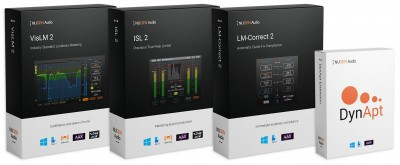Two Decades of Development With DK-Technologies
Author: Dennis Lennie
Published 1st January 2010
For more than 20 years, DK-Technologies has been developing audio and video test and measurement products that have become industry standards thanks to their adoption by many of the world’s top music, broadcast and post production facilities.
Founded in 1987 by its current CEO Karsten Hansen, DK began by developing complex, custom-designed matrix systems for individual broadcasters. In 1993, it launched a range of stand-alone audio metering products that could be sold as individual units. These were based on recently introduced DSP technology and incorporated LCD screens showing clear visual representations of the audio signal. Known collectively as Master Stereo Display units, the first – the MSD 550 – went on show at the AES Convention in Vienna in 1994.
"Most people thought this was just a toy, a funny thing that was interesting but had no serious application,” Hansen says. “It took a while for people to see its potential, but as soon as their thoughts turned to 5.1 surround, they realized where we were coming from and began to take these new meters seriously.”
In 1998 DK introduced its first 5.1 surround meter, the MSD 600C MkI. To help engineers monitor these complex audio signals, DK introduced a revolutionary new display technology called JellyFish™, which takes its name from the shape the signal produces on the LCD display. JellyFish™ – and DK’s subsequent StarFish™ display, which shows an image of the acoustic audio levels as they are experienced by the listener - have become industry standards, especially for people working in surround. The company also leads the way in loudness metering, having developed software and stand alone products that incorporate ITU recommended algorithms. These, too, are rapidly becoming industry standards.
Although DK's primary reputation was for developing really useful audio metering products, things changed in 2001 when the company acquired the Studio Products Division (PTV) from ProTelevision Technologies A/S. This acquisition brought all sorts of synergy between audio and video product development and gave DK the opportunity to set up a platform for combined technology that addressed the existing and future needs of end users.
The existing PTV product range was in need of modernisation and the first to get the DK treatment was the signal generator, which was revamped to incorporate HD test signals.
Next on the list was the waveform monitor – a vital piece of equipment, but one with a display technology that had basically remained the same for more than 40 years. DK’s design team got to work on the product and by NAB 2008 had created the PTO760M. The PTO760 is effectively four HD/SD waveform monitors in one box, making it ideal for Camera Control Units as it can monitor up to four cameras from one compact unit.
“Apart from production studios and Master Control Rooms, the greatest demand for waveform monitors comes from the Outside Broadcast market,” Hansen says. “OB vehicles have limited rack space, not to mention concerns about the weight of equipment and the amount of heat each unit generates. If you need a conventional waveform monitor for each camera and you have 12 cameras on your truck, then you’re looking at 12 units. But if you can monitor more than one camera with each waveform monitor, then suddenly you gain a great deal of valuable rack space.”
The award-winning PT0760M quickly notched up sales to a number of key broadcasters including Visions, which used it during its Wimbledon 2008 and Olympic Games coverage in China. In recent months DK has added to the range by introducing the PTO710M, an entry level single channel version of the PT0760M featuring plug-in modules and software options that allow it to be upgraded to a full 4-channel waveform monitor with audio. It has also launched the PT0700-R, a remote unit that allows engineers to access the facilities of the PT0760M from an entirely different location. With this unit in place, an engineer on location can see exactly the same audio and video display as the engineer in the Master Control Room – and he can independently access all the facilities of the PT0760M without interrupting the use at the master location.
DK has never been afraid of change and has consistently pushed the boundaries in its bid to develop new technologies that satisfy the needs of the broadcast and post production industries. The PT0760M and PT0710M form the basis for all future HD/SD video products and take DK firmly into the video domain.
"Positioning ourselves for the future means thinking differently,” Hansen says. “Conceptual thinking has always been our core philosophy and we are now ideally placed to bring the benefits of an open minded, no constraints approach to the entire industry."



















